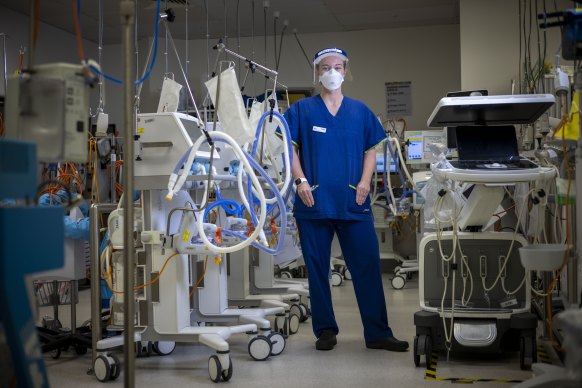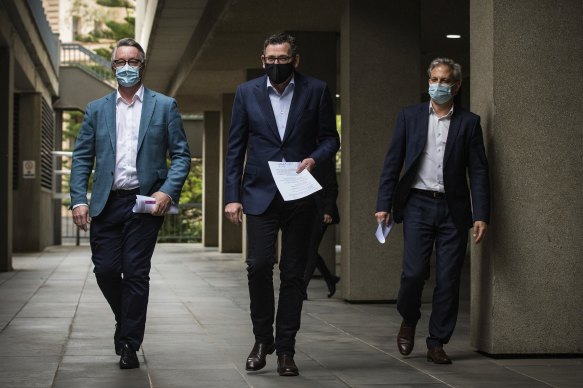This was published 3 years ago
Hospitals likely overwhelmed, road map modelling shows
By Liam Mannix
Modelling conducted for the Victorian government predicts its road map out of lockdown has a better than one-in-two chance of exceeding the state’s hospital and ICU capacity, and will lead to the deaths of between 1455 and 3152 people.
Avoiding such a scenario, if possible, will require an enormous last effort from Victorians over the coming two months – redoubling efforts to stop the virus spreading even as the vaccination rate rises.
Had Victorian Premier Daniel Andrews chosen to maintain lockdown after 80 per cent vaccination coverage had been reached, it would cut the chances of overwhelming hospitals to one in four and projected deaths by between 786 and 1726, modelling by the Burnet Institute predicts.

ICU nurse Tayla Christofakakis, at Austin Hospital in Heidelberg on September 15. Victorian government modelling suggests a substantial risk ICU capacity could be exceeded soon.Credit: Wayne Taylor
The reopening road map, announced on Sunday, creates “significant additional risk,” the modellers note.
“The modelling clearly shows, for Victoria to open up and not put the health system under enormous pressure is extremely difficult,” said Professor Margaret Hellard, co-author of the modelling.
“The hospital system is going to be put under stress. Our job as Victorians is to try to help cut that stress, by doing everything we can possible,” she said. “We are requiring a final, last, one-to-two months of huge effort.”
The Burnet’s modelling predicts a first peak in daily average infections of between 1400 and 2900 in the last two weeks of October. In a quarter of simulations, hospital capacity is exceeded despite Melbourne being in lockdown.
A second larger peak is forecast for mid-December, caused by increased virus transmission as restrictions ease, before case numbers fall away.
Between July and December 2021, between 1455 and 3152 Victorians are projected to die of COVID-19 under the road map, including the 11 deaths in the current outbreak.
Two more-optimistic scenarios are modelled: one in which people who are fully vaccinated continue to get tested at high rates if they have any symptoms (the modelling notes this may be “difficult to achieve”), and one in which a 15 per cent reduction in non-household transmission can be achieved.
“That needs a major effort on Victorians’ behalf. It needs them to wear masks. To not visit each other in homes over the next month,” said Professor Hellard.

Victorian Health Minister Martin Foley, Victorian Premier Daniel Andrews and Victorian Chief Medical Officer Brett Sutton arrive at the daily press conference on Sunday.Credit: Darrian Traynor
Even under those optimistic scenarios, there was an 18 to 29 per cent chance of hospital capacity being exceeded.
These projections are very uncertain and subject to a lot of random chance as the epidemic is only in its earliest days. Importantly, Mr Andrews suggested the pace of reopening could change depending on the load on the healthcare system.
“[The modelling] makes assumptions, it assumes things that will happen and won’t happen over a period of time,” he said.
“I want to make it very clear to all Victorians, particularly to those working in our health system, as we deliver this road map, we will monitor every hour of every day, how many people are in hospital, how much pressure is there on our health system. Are we balancing that? Are we able to continue to provide the best care to everyone that needs it?”
Mr Andrews called the Burnet Institute’s modelling “sobering reading”. It was the cost of reopening, he said.
“We cannot permanently suppress this virus… we have got to open the place up because remaining closed forever has its own cost.
“We are opening up, no doubt about that. There will be no turning back. We have to normalise this, we have to pass through this pandemic.
“We cannot have a perpetual suppression of this virus. There will be pain, it will be challenging.”
The other option the Premier had was to remain in lockdown past the 80 per cent double-dose vaccination milestone, said Dr Michael Lydeamore, a Monash University researcher who has contributed to the Doherty Institute’s reopening modelling.
That would keep numbers lower – although still with a significant risk of overwhelming the healthcare system.
“Public health is all about taking these trade-offs,” he said. “We’ve been in lockdown now for two years, basically. That’s OK for people like me. But think about six-year-old kids. They have missed two years of school. There comes a time when it’s a risk you end up willing to take”
Both Dr Lydeamore and Associate Professor James Trauer, head of epidemiological modelling at Monash, said the plan was a sensible, cautious and evidence-based move toward reopening.
“Overall, it’s a pretty good plan, and gets the balance about right,” said Professor Trauer. “It lands a little toward the cautious side.
“It recognises the importance of airborne transmission as being really critical to the spread of COVID. Clearly, airborne transmission is critical to the transmission of Delta.”
Liam Mannix’s Examine newsletter explains and analyses science with a rigorous focus on the evidence. Sign up to get it each week.